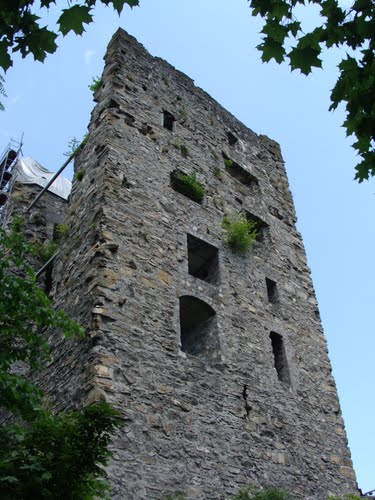

Location: Vorarlberg Map
Burgruine Neu-Montfort, also known as Burg Neu-Montfort or Neu-Montfort Castle Ruins, is a medieval hilltop castle ruin located in the Austrian state of Vorarlberg. Constructed in the early 14th century by the noble Counts of Montfort-Feldkirch, it served as a fortified residence and strategic outpost overlooking the Rhine Valley. The castle exemplifies simple yet robust medieval architecture typical of the region, designed for defense amid the turbulent politics of the Holy Roman Empire. Though it fell into disrepair by the late 17th century and remains a ruin today, it has undergone periodic restorations and archaeological investigations, preserving its historical value as a landmark of local heritage.
The ruins are situated near the town of Götzis in the Feldkirch district of Vorarlberg, western Austria, close to the borders with Switzerland and Liechtenstein. Specifically, they perch on the northeastern foothills of the Therenberg mountain, at an elevation of approximately 513–516 meters (1,683–1,693 feet) above sea level. The coordinates are 47°19′41″N 9°38′42″E. This elevated position provides commanding panoramic views over the Rhine Valley toward Lake Constance (Bodensee), making it a scenic vantage point. The site is accessible via hiking paths from Götzis, integrating it into the region's natural landscape of rolling hills and alpine terrain.
The construction of Neu-Montfort Castle began around 1311 and was
completed by 1319 under the orders of Counts Rudolf III and Ulrich II of
Montfort-Feldkirch, a branch of the influential Montfort family. It was
built as a new fortified seat, possibly on the remnants of an earlier
castle complex that may have belonged to the Welf dynasty and was
destroyed before 1269. The first documented mention of the castle dates
to 1319, reflecting its role in consolidating the family's regional
power.
In 1363, the Counts of Montfort sold their dominion, including
the castle, to the Habsburgs, marking the latter's first territorial
acquisition in Vorarlberg (though some sources note the transfer as
occurring in 1390). During the Appenzell Wars (1405–1408), a series of
conflicts between the Swiss Appenzellers and Habsburg allies, the castle
was occupied by the League Above the Lake (Bund ob dem See) and served
as a military base. Remarkably, it was one of the few fortifications in
the region to survive the wars without destruction.
Ownership shifted
multiple times in the following decades: it was pledged to the Counts of
Nellenburg and then to Count Friedrich of Toggenburg in 1417 before
reverting to Habsburg control in 1436. The castle continued to function
as an administrative and residential site, with the last significant
renovations occurring under Eitel Hans Gienger, the bailiff of the
Feldkirch lordship. However, by the end of the 17th century, following
the death of its last resident administrator, Ulrich Koch, in 1693, the
castle was abandoned and began to decay.
The 19th century saw
structural collapses, prompting safety measures in 1913. Further
restorations focused on the ring wall in 1970 and 1974–1975, with
additional repairs in the 1960s and 1970s. Despite these efforts,
ongoing deterioration occurred, including a window collapse in 1992 and
cracks from an earthquake in 1998, leading to the closure of the keep
area for safety. In 2020, archaeological excavations revealed
significant artifacts, such as decorated tiles from a 15th–16th century
tiled stove and the cellar of the palas, shedding light on daily life at
the castle.
Neu-Montfort's design is relatively straightforward for a medieval
hilltop castle, emphasizing functionality and defense over
ornamentation. The core structure consists of a massive five-story
bergfried-like residential tower, which served as both a keep and living
quarters. This tower features a high entrance on the northeast side at
the level of the second floor, a common defensive measure to hinder
access during sieges. Attached to the west is the palas (residential
wing), now largely ruined and barely recognizable, along with remnants
of the ring walls that enclosed the site.
The outer walls of the
imposing residential tower remain the most prominent surviving elements,
constructed from local stone to withstand assaults. The overall layout
reflects the castle's role as a compact stronghold, with limited
expansions beyond the initial build. Archaeological findings, such as
the tiled stove remnants, indicate interior comforts like heated rooms,
typical of noble residences in the late medieval period.
Today, Burgruine Neu-Montfort is owned by the municipality of Götzis and is protected as a cultural heritage site under Austrian law. While parts of the ruins, particularly the keep, are closed to the public due to structural instability from past damage and natural events, the site is generally accessible for visitors via hiking trails. It serves as a popular destination for history enthusiasts and hikers, offering not only glimpses into medieval architecture but also stunning views of the surrounding Rhine Valley and Lake Constance. Ongoing preservation efforts continue, with the 2020 excavations highlighting its archaeological potential. The ruins are not inhabited or commercialized, maintaining their authentic, atmospheric decay.
Survival and Resilience: Its intact survival through the Appenzell
Wars distinguishes it from many neighboring castles that were razed,
underscoring its strategic importance.
Archaeological Value: Recent
digs have uncovered artifacts that provide insights into medieval daily
life, such as heating systems and structural foundations.
Cultural
Landmark: As a symbol of Götzis, the ruins feature in local tourism,
cycling routes, and historical narratives of Vorarlberg's integration
into Habsburg territories.
Visitor Appeal: The site's elevated
location makes it ideal for outdoor activities, though visitors are
advised to respect closures and check local regulations for safety.
In summary, Burgruine Neu-Montfort stands as a poignant reminder of
medieval Vorarlberg's feudal history, blending defensive architecture
with the natural beauty of the Alps, and continues to intrigue through
its preserved ruins and ongoing discoveries.